Carthaginian Coinage › Carthaginian Government » Ancient origins
Articles and Definitions › Contents
- Carthaginian Coinage › Antique Origins
- Carthaginian Government › Antique Origins
Ancient civilizations › Historical and archaeological sites
Carthaginian Coinage › Antique Origins
Definition and Origins
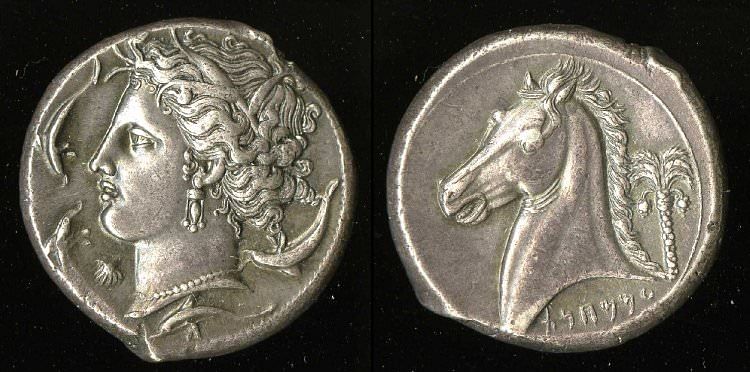
The coinage of Carthage was first minted from the 5th century BCE. Initially adopting the drachma, the Carthaginians later minted silver shekel coins. Designs were instantly recognisable, as intended, and included famous figures such as Hannibalor local flora and fauna like the palm tree and elephant.
FROM BARTER TO COINAGE
Carthage, like its Phoenician founders and many other ancient Mediterranean trading cultures, was a relatively late entrant into the world of coins. Greece and its colonies had already been using them for several centuries. Barter and exchange were the tried and tested form of payment in the ancient world prior to coinage, and this system was particularly useful for nations like Carthage which traded in far-flung places where minted coins were less useful and their value not always recognised.Eventually, though, the convenience of transporting ingots of specific weights made from precious and semi-precious metals convinced the Carthaginians to adopt this method, and from there it was but a small step to minting even more manageable forms of payment in the shape of coins.
BY THE END OF THE 4TH CENTURY BCE THE DRACHMA WAS ABANDONED IN FAVOUR OF A NEW DENOMINATION, THE SHEKEL.
The first Carthaginian coins were not actually minted at the home city of Carthage but in Sicily sometime in the late 5th century BCE, not coincidentally, a place which had long produced its own coins. The beginning of a Carthaginian controlled mint was likely driven, as it had been earlier in wider Greece, by the necessity to pay mercenary troops. Soldiers in the field did not have much use for heavy metal ingots and nor could they conveniently carry about large quantities of goods such as grain or other foodstuffs. The military campaigns of Carthage in western Sicily from 409 and 405 BCE and the arrival of coinage were not, then, unrelated.
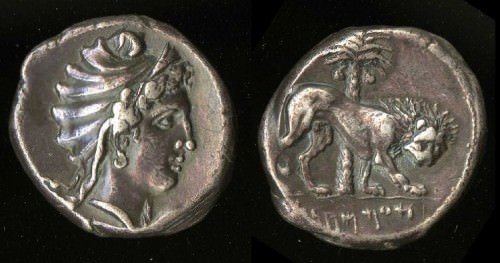
Dido, Carthaginian Tetradrachm
THE DRACHMA & SHEKEL
The first Carthaginian coins were made of either silver or bronze and copied the Greek tetradrachm (four-drachma) coin and its denominations famously produced by Athens. They were minted in the fashion typical of the time by hammering a smooth metal disk between two engraved dyes. A Carthaginian silver tetradrachm coin weighed around 17 grammes. From the 4th century BCE new more valuable coins were added to the range made of electrum (a gold and silver alloy) and the pure gold stater, which was equal to 20 drachmas. The 4th century BCE also saw Carthage mint coins at home, and by the end of that century, the drachma was abandoned in favour of a new denomination, the shekel, which was a heavy silver coin (c. 11 g).There were fractions of a shekel coins for smaller purchases, and two, three, or even six (c. 44 g) shekel coins for the bigger spenders.
When Carthage conquered southern Spain in the 3rd century BCE and gained control of the rich silver mines there, local mints were established to immediately cash in on this new bounty. Sardinia was another important mint, particularly during the First Punic War (264-241 BCE) when Sicily came under threat. When things started to go badly for Carthage against the might of Rome, their silver coins began to include less and less silver.

Hamilcar Barca
COIN DESIGNS
Coins in the ancient world were an important means to convey political and cultural messages by presenting the heads of rulers and figures from local mythology. Carthage was no different, and their coins depicted such important figures as Dido(aka Elissa and distinguished by her soft Phrygian cap with long neck and earflaps) who was the legendary founder of Carthage, the god Melqart (typically wearing a lionskin headdress and/or carrying a club), the goddesses Tanit, Astarte, and more rarely Isis, and the great generals Hamilcar Barca and Hannibal. Other popular and instantly recognisable designs were a ship's prow, the palm tree, horse (either just the head or whole), lion, and war elephant.
Carthaginian coins sometimes bore legends as well as pictures which included the city of issue, such as Sys (Panormus) and Qart - hadasht, or words indicating their immediate destination: mhnt (army), 'm mhnt (people of the army), mhsbm(paymasters), and b'rst ('in the territories', eg Sicily and Spain).
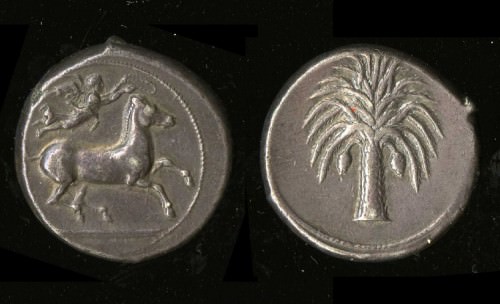
Carthaginian Silver Coin
Carthaginian coins were, then, an eclectic mix of Greek designs and Carthage's own artistic tradition, leading historian Dexter Hoyos to conclude that "the Carthaginian's ability to adopt, adapt and develop what they wanted from other cultural worlds is no less evident in their coinage" (121). That the coins were a success and helped drive Carthage's trade-based prosperity is evidenced by archaeologists finding them not only in Spain, Sicily, and the Italian mainland but also in such far-flung places as the Balkans and the Azores.
Carthaginian Government › Antique Origins
Definition and Origins
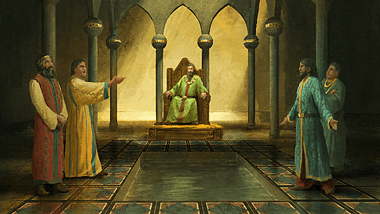
The government of Carthage was based on a system of elected officials accountable to a popular assembly. Unlike its founding city, Tyre in Phoenicia, Carthage did not have a monarchy but its politics was dominated by an aristocratic elite which was composed of competing clans and which held all important political, judicial, and military positions. As in other contemporary ancient cultures participation in political life and the popular assembly of the city was limited to those who held citizenship – indigenous and free males. Although the system was praised by such noted figures as Aristotle, some of the exact workings of the Carthaginian government have remained elusive, a situation further confused by Greek and Romanwriters using their own familiar terminology to describe the political institutions of Carthage.
SUFFETES
The most powerful office in the Carthaginian government was held jointly by two magistrates elected annually known as suffetes (Latinized from the Punic sptm or shophetim and conventionally translated as 'judges'). These had replaced the initial system of monarchy sometime in the early 7th century BCE, and so their association with purely judicial matters may too have widened in political scope as the office evolved. It is also possible that there was only one suffete in the first century or so of the new system. From the 5th century BCE electing two suffetes becomes standard, one leading the armed forces of Carthage when at war and the other running the government at home. Greek and Roman sources indicate that the suffetes operated in collaboration with the senate and were also concerned with civil lawsuits. Wealth and family background seem to have been the two most important factors in being considered eligible for the role. The position of suffete continued to exist even when North Africa became a Roman province and is recorded at least until the 2nd century CE.
SENATE
Carthage, even under its earliest form of monarchy, had a senate composed of influential citizens. These members were known as drm or the 'great ones' and held the position for life. Just how these senatorial members were selected is unknown, but it is likely they numbered between two and three hundred. They met in a building in the marketplace of Carthage but also sometimes at the temple of Eshmun on the Byrsa hill. The suffetes would consult the senate on government policy – military, diplomatic, and financial matters - and if the two sides disagreed, then a deciding vote would be held in the popular citizen's assembly (see below). Also, if one suffete was not in agreement then, again, the assembly would be consulted.
THE GOVERNMENT OF CARTHAGE WAS LED BY TWO SUFFETES WHO PRESIDED OVER A SENATE & CITIZEN ASSEMBLY.
We know that the senate decided on declarations of war, whether or not to send additional armies to support generals in the field, punishments for commanders who failed in their objectives, and whether to accept peace terms offered by the enemy.The senate also sent representatives with Hannibal ’s army in Spain and Italy and signed the commander's peace treaty with Macedon in 215 BCE. However, it is also true that commanders often acted quite independently when campaigning across the Mediterranean, which led the Athenian politician Isocrates to state that Carthage was "ruled by an oligarchy at home, by a king in the field" (Miles, 146).
SENIOR OFFICIALS
Certain senators were selected to special commissions. Aristotle describes these as consisting of 5 members (hence their name 'pentarchies') who acted as judges in law courts, but Punic inscriptions only mention a 10-man commission responsible for religious sites and a 30-man commission which supervised taxation. In addition, there was a state treasury ( mhsbm ) headed by a single treasurer ( rb ) who is mentioned in one inscription as imposing penalties on those merchants who failed to pay customs duties. Other important state officials were the head of the priests ( rb khnm ) and the head of the army ( rb mhnt), the latter very often also being a suffete in important conflicts.
All of these positions were elected, and all seem to have had a limited term of office, with the exception of the general who served for the duration of a war. These limitations were, no doubt, to prevent individuals from becoming too powerful, but it does not seem to have curbed corruption. Bribery - for votes, favourable decisions, and access to high positions – and embezzlement were such a problem that Hannibal's first task on being elected suffete was to improve the endemic corruption which was crippling the state's finances. Corruption was not helped by the absence of a salary for state officials, a fact which also meant that such positions were only open to those with a source of private income.
From the 5th century BCE a special branch of the senate composed of 104 members convened to assess the military performance of commanders on completion of their campaign. We imagine that the number is derived from 100 senators plus the two suffetes, the treasurer and the head of the priests. Senatorial membership of the council of 104 was for life. It was responsible for deciding the fate of generals and admirals who failed in a campaign with punishments ranging from fines to crucifixion.
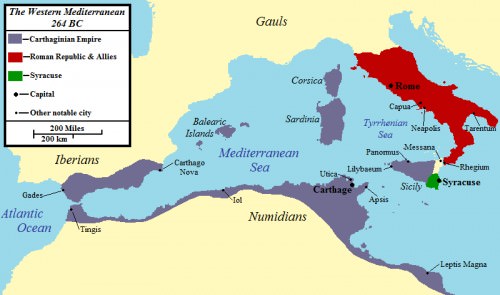
The Western Mediterranean 264 BCE
Another important group of officials was those administrators selected to govern the provinces controlled by Carthage. Allied cities such as Utica and Cadiz, and subject territories in North Africa were allowed a high degree of political autonomy except in military matters and foreign affairs. In return for Carthage's protection they did have to pay tribute in money, arms, and men for military service. Regional officials would have supervised this and collected such additional taxes as custom duties.
All of the key political positions in Carthaginian government were dominated by a ruling elite. This aristocracy was characterised and dominated by opposing families ( mizreh ), notably the Barcids and Magonids. Nevertheless, for enterprising citizens, especially rich merchants, there was the possibility to join this aristocracy as wealth was the overriding factor for success in politics. On the other hand, the traditional elite was composed of those who could claim descent to the colony's founding fathers, and it is clear that genealogy was an important consideration. This perhaps explains the rather confusing repetition of names from generation to generation resulting in literally hundreds of Hannos, Hamilcars, and Hannibals.

Hamilcar Barca
ASSEMBLY & CITIZENSHIP
The popular assembly of Carthage was known as the 'm (pron. ham ) which translates as 'the people'. They met in the market square of the city, and their main powers were to vote on issues proposed by the suffetes and senate, and the election of officials, including the suffetes, chief priest and treasurer, and military commanders. Qualification to attend the assembly, beyond holding citizenship, and the system of voting are not known.
Citizenship was reserved for males from the city of Carthage. Women, slaves, and foreigners could not enjoy citizen status.There are some indicators in the historical record that there may have been a second tier of citizens composed of former slaves and foreign artisans. The existence of two levels of citizenship, though, continues to be debated amongst historians.Citizens were organised into memberships ( mizrehim ) or family clubs which were distinguishable from each other via their devotion to a specific god, the profession of their members, or perhaps even composed of those who had fought together in battle. Such memberships regularly bonded through shared banquets.
Citizens of allied cities in North Africa had a similar or equal status to their counterparts at Carthage in regards to civil law. The status of those who lived in the smaller settlements of the areas under Carthaginian control is not known. More certain is that the level of integration of peoples into the Carthaginian empire was quite low with the consequence that in times of peril, such as the Punic Wars with Rome, many cities defected to the Roman side. Carthage exploited its colonies but made no real efforts to foster a sense of belonging in their allied and conquered states, which meant that when Carthage fell, so too did its empire.
LICENSE:
Article based on information obtained from these sources:with permission from the Website Ancient History Encyclopedia
Content is available under License Creative Commons: Attribution-NonCommercial-ShareAlike 3.0 Unported. CC-BY-NC-SA License